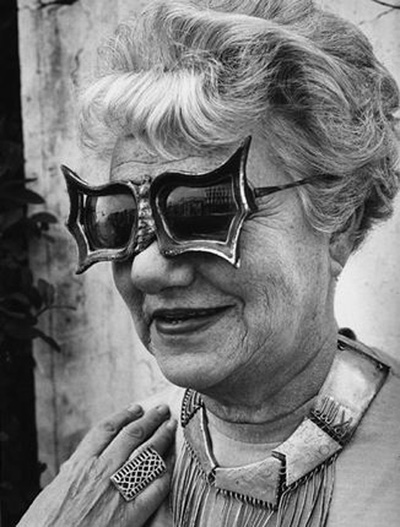

PEGGY GUGGENHEIM WAS ONE OF THE twentieth century’s great bon vivants. How fitting that her home base for thirty years was this airy palazzo on the Grand Canal. Today it’s filled with a fabulous collection of modern art she acquired, including paintings and sculptures by such masters as Picasso, Kandinsky, de Chirico, and Mondrian.
Peggy’s spirit lives on in these surroundings that resonate with the spicy times she and her artist friends had here from 1949 to 1979. You can imagine her stepping off the terrace into her private gondola for her daily ride, which she took religiously at sunset, wearing a flamboyant get-up and those signature butterfly-shaped sunglasses.
Born in New York in 1898, Peggy was the free-spirited rebel of the wealthy Guggenheim family. Her father died in the sinking of the Titanic when she was fourteen. When she came of age and inherited her fortune, she took off for Europe and married writer Laurence Vail, who was nicknamed King of the Bohemians. They honeymooned in Capri, lived in Paris, and bopped around the continent, stopping in Venice where her lifelong passion for the place took hold.
By the time she was thirty-nine, Peggy was divorced, her two kids were in boarding school, and as she puts it, “I needed something to do.” A friend suggested she open an art gallery.
Even though she knew nothing about modern art, she dove in, with Marcel Duchamp by her side to educate her. She made a vow to buy one painting a day and decided, taking Samuel Beckett’s advice, that she would only buy the work of living artists. Duchamp and Beckett were not only friends who guided her along. They were just two of Peggy’s myriad line-up of lovers she became famous for throughout her life. When asked in her later years, “How many husbands have you had, Mrs. Guggenheim?” she cracked back: “D’you mean mine or other people’s?”
Her first gallery show in New York made a big splash—introducing the world to painters such as Robert Motherwell, Mark Rothko, and Jackson Pollock. It was Peggy’s generous patronage of the American avant-garde that helped to bring international recognition to the movement.
“I have never been to a city that has given me the same sense of freedom as Venice,” Peggy says in her autobiography. In 1949, when she was fifty-one, she settled there, buying the Palazzo Venier dei Leoni in the Dorsoduro sestiere. The eighteenth-century, one-floor building was perfect for her to sunbathe on the roof and display her sculptures in the garden. Little by little, more and more of her home became gallery space, and while she lived there, she opened it to the public a few afternoons a week. She willed the palazzo to her uncle’s Solomon R. Guggenheim Foundation, so today it’s been expanded and stands as one of the world’s most important small museums of contemporary art.
The Peggy vibe throughout the museum is palpable. A fantastic silver headboard designed by Alexander Calder graces what was her bedroom. A pair of paintings by the surrealist Max Ernst feature monstrous half-naked female images, draped in orange capes, interpreted as being inspired by Peggy. She was married to Max from 1942 to 1946. It was a tumultuous relationship, largely because Max was still in love with Leonora Carrington, a surrealist painter whom he’d left behind in France when Peggy helped him to escape the Nazis and come to America.
One of the first sculptures Peggy bought for the villa appears center stage on her terrace: The Angel of the Citadel by Marino Marini. This Etruscan-inspired bronze features an ecstatic rider on horseback—so ecstatic he has an enormous hard-on. Peggy loved peeking out from her sitting room to watch visitors’ shocked reactions to the statue. And out of respect, because the terrace faced the Venetian prefect’s home, she had the figure cast with a removable penis, so when nuns rode by on their way to get the patriarch’s blessing, she’d remove it.
Peggy died at eighty-one and her ashes are buried in the museum’s garden, alongside those of fourteen beloved Lhasa terriers she kept throughout her Venetian life. Nearby is an olive tree (a gift from Yoko Ono), and sculptures by such artists as Arp and Moore.
Along with the great collection, this place has wonderful docents. In contrast to most Italian museums, where employees typically slump on folding chairs and bark “No photo!” from time to time, here you’ll find young, enthusiastic types. They’re art students from all over the world on Guggenheim internships, thrilled to be in Venice and delightful to talk to about what Peggy collected. Just as Peggy brought a fresh spirit of adventure to Venice, these docents keep her spark alive.
Peggy Guggenheim Collection: open daily 10-6, closed Tuesday (www.guggenheim-venice.it)

Golden Day: Visit the museum, lingering a while in the caffè for a drink (hot cocoa on a wintry day is fab) or snack. Enjoy the Dorsoduro neighborhood, with a stop by Cantinone Già Schiavi wine bar (Fondamenta Nani 992), and eat at Ai Gondolieri, a romantic, old school place for such specialties as Fegato alla Veneziana, liver and onions. It’s one of the few places in Venice that doesn’t serve fish. (Sestiere Dorsoduro 366, 39 348 808 9829, closed Tuesday, www.aigondolieri.it)
TIP: Speaking of contemporary art, every two years (odd ones), there is the Venice Biennale, an international exhibition featuring artists from all over the world. www.labiennale.org
RECOMMENDED READING
Out of This Century: The Autobiography of Peggy Guggenheim by Peggy Guggenheim
Art Lover: A Biography of Peggy Guggenheim by Anton Gill